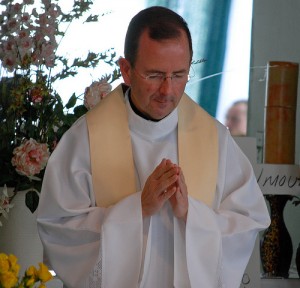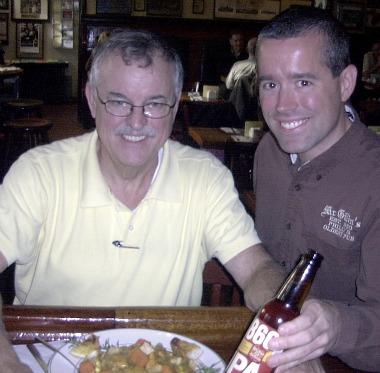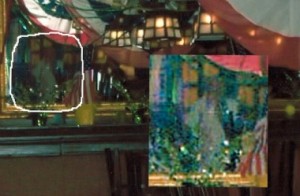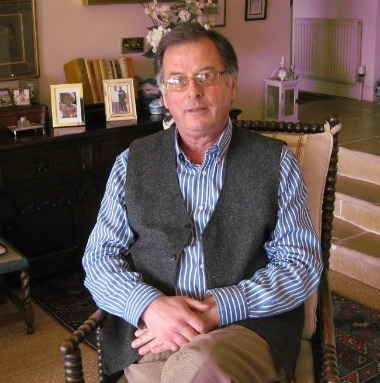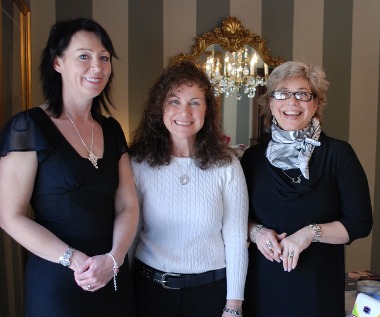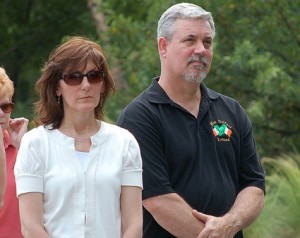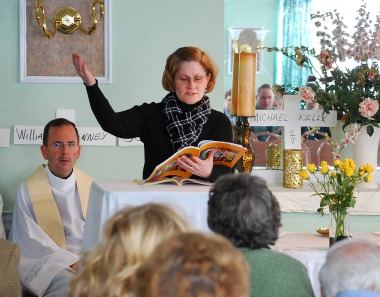
Festival organizer Bill Reid gets a bagpipe lesson from Rathkeltair's Neil Anderson.
When I caught up with Bill Reid on his cellphone early Monday morning, he admitted he was “in panic mode.”
By next Friday, the first of thousands of people would be coming to the Valley Forge Convention Center for the opening concert of the Mid-Winter Scottish-Irish Festival Reid and his wife, Karen, have been organizing for 19 years. This year, he bagged his mailing list because he thought it was too old and used the list compiled by the organizers of Irish weekend in Wildwood. Some of his regulars didn’t get their usual postcards and they were calling. “Aren’t you having the festival this year?”
Yes he is. And it’s bigger than ever. And I have to say, for a guy in panic mode, Reid is really funny. I may call him every Monday morning to get the week off to laughing start.
The best part of this year’s festival: “There’s nothing downstairs,” says Reid, who is of Scottish ancestry. That means no pet lovers, computer geeks or swingers competing for parking spaces in the convention center lot or stools at the local bar. There’s only one convention in the building and it’s Celtic.
That sent Reid off on a trip down memory lane. The Pet Expo was a mess, he says. Really. And you know what he means. But the swingers’ group provided an even more embarrassing moment for Reid.
“I came in to the pre-convention meeting and was sitting with everybody and I innocently asked, ‘Where’s the swing group’s band?’ They all looked at me and someone finally said, ‘Billllll.’ Not those kind of swingers. On the bright side, at night after the festival is over we usually go over to the bar and there was plenty of room. They were off doing what they do.”
Then there was the gay and lesbian group who held a pajama party one night on the floor of the convention center. “If anybody else had walked around the corridors the way they were dressed—or not dressed. . . .” He laughs.
He’s had to handle plenty at his own festival too. “One year we had the Daughters of the British Empire take a table and we put them next to an AOH group. The first thing the ladies did was put up a picture of the Queen and a Union Jack. The AOH guys came to me and said, ‘Hey Bill, we thought there was no politics here.’ So I went over to the ladies and said, ‘do you know where you are?’ They were nice about it. They said, ‘Maybe we can take the flag down.’ What I about the Queen? I asked. The guys said, “Oh no, she can stay.’ By the end of the weekend the ladies were feeding them biscuits and the guys were helping them take down their display.”
At this point I’m thinking that maybe they should have tapped this Scotsman who traces his roots back to Paisley, near Glasgow, Scotland, to hammer out a peace accord in Northern Ireland. He accomplished in three days at Valley Forge what it took decades there. He even handles the division of labor among the vendors. “I like to be on the floor at 6:30 AM to make sure that the husbands who are there to help their wives set up help their neighbor instead. The woman there won’t yell at the guy and he won’t yell at her. It’s all peaceful then.”
That may be the only time during the three-day festival that’s it’s peaceful. Reid keeps the music cranking all day and all night long, with headliners such as the Kansas City-based group, The Elders, who describe themselves as “arse kicking Celtic Music from the heartland;” The Young Dubliners, who hail from L.A.; Seven Nations, a Florida-based Celtic/punk/metal band with longevity (around since 1993, the year the Reids launched their festival); and Albannach, whose warlike tribal music (heavy on the drums) every year draws the kilted goth crowd wearing the traditional t-shirt that reads “Outlawed tunes on outlawed pipes.”
Albannach almost got Reid into trouble with his 90-year-old mom. “She’s learned to do the Internet, email and all this. One day she went online and put in our company name, East of the Hebrides. The next thing you know my sister gets a call. ‘What is your brother doing with those tattooed men?’”
One festival regular, Brother, an exciting band with an unusual sound, is especially near and dear to Reid’s heart. Formed by a group of Australian brothers, it combines tribal drums, bagpipes and didgeridoo, a wind instrument invented more than 1,000 years ago by aboriginal people in Northern Australia. Brother’s didgeridoo player is not Australian however. He’s a local native known widely “DidgeriDrew”—and he’s the Reids’ son, Drew.
“He’s the only American,” says Reid proudly. “We were once on a plane with Solas and they wanted to know, ‘how come you never hire us?’ I said, ‘Because you’re too expensive.’ We were on our way to Denver to an Irish festival to see our son and we told them he plays with a band called Brother. Winnie, their fiddler, looks at us with surprise. ‘Your son is DidgeriDrew!’ We ran into Joanie Madden of Cherish the Ladies and she said the same thing. Turns out Drew had backed up Cherish the Ladies. That’s when I realized that I was no longer important.” He laughs.
Also on the bill this year are rockers Rathkeltair of Florida and Hadrian’s Wall from Ontario; the McLeod Fiddlers (an amazing group of young musicians from Canada); the Paul McKenna Band from Scotland; Scottish folkies, the Tannahill Weavers and Annalivia, a fiddle band drawing on musical traditions from Appalachia, Cape Breton, Scotland, Ireland and England; and local talent Seamus Kennedy, Charlie Zahm, Jamison Celtic Rock, and the Hooligans. There are also plenty of workshops , including dance classes with Rosemarie Timoney on the Irish side and Linette Fitch Brash on the Scottish end; fencing lessons; Irish lessons; a didgeridoo-making class, and a session with Hadrian’s Wall (bring your own instrument). There’s even a workshop called “What the heck is a bagpipe?” for those inquiring minds who’ve always wanted to know and, as always, Scottish and Irish whiskey tastings. And, of course, vendors—about 40 of them, hawking everything from fine Celtic jewelry to rude t-shirts.
You’ll also see Bill Reid running around, putting out fires and occasionally starting some. He’s sharing emcee duties next weekend with Dennis Carr of the Brigadoons of Canada.
And he assures us that most of the “snowbergs” are gone from the parking lot so there are plenty of spaces. Planning a festival whose first name is “midwinter” can be fraught with anxiety. “I got an email today from someone who asked me if I was worried about the weather,” says Reid. “I said, ‘Did you have to bring up that word?’”
The 19th Annual Mid-Winter Scottish-Irish Festival kicks off on Friday, February 18, with an evening concert with Albannach, the Young Dubliners, the Hooligans and Jamison, and runs through Sunday at the Valley Forge Convention Center at Gulph Road and First Avenue in King of Prussia, just off the Valley Forge exit of the Pennsylvania turnpike. Check out our calendar for details or go to the East of the Hebrides website.
Check out some of the action from past festivals.

